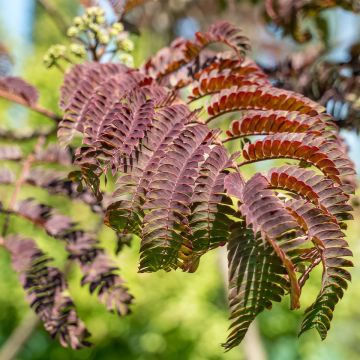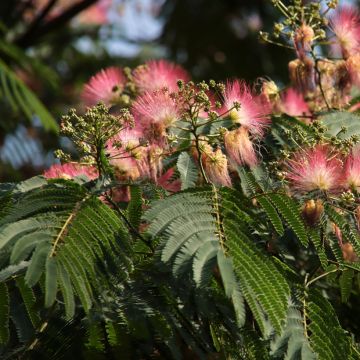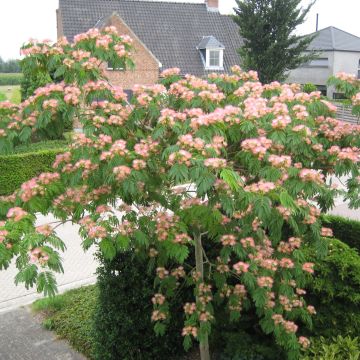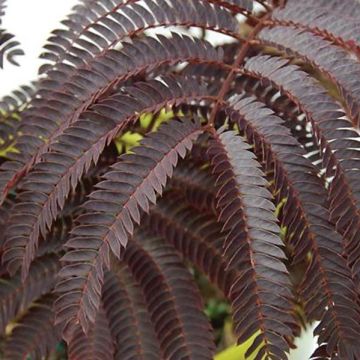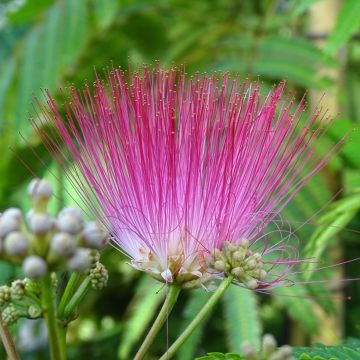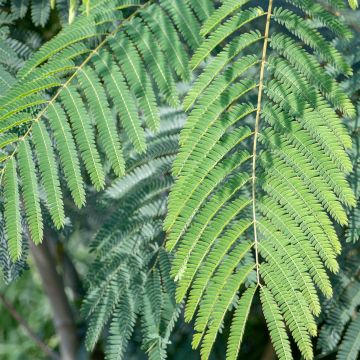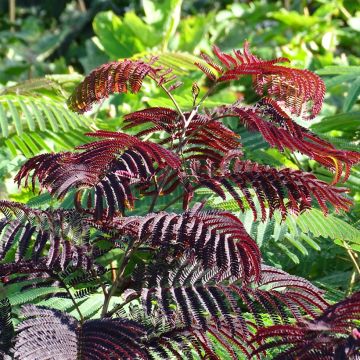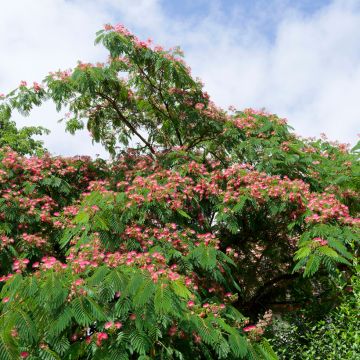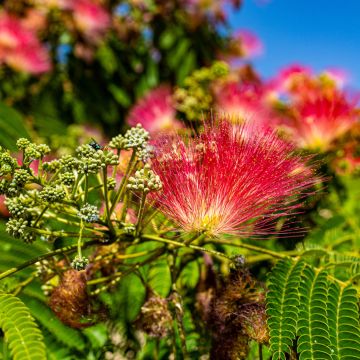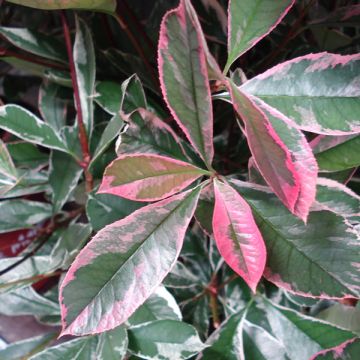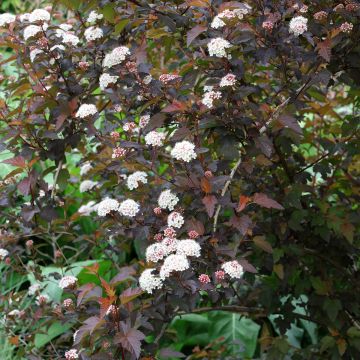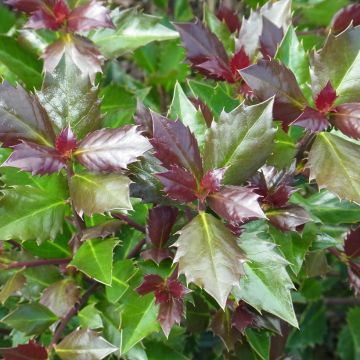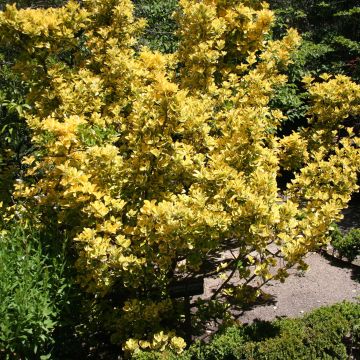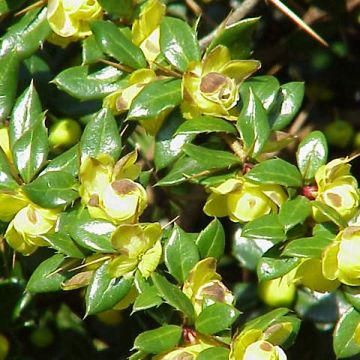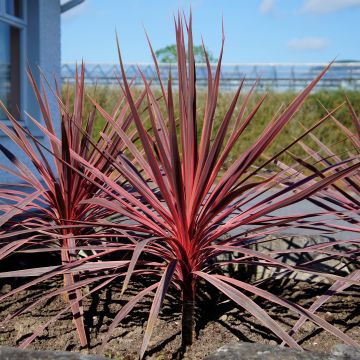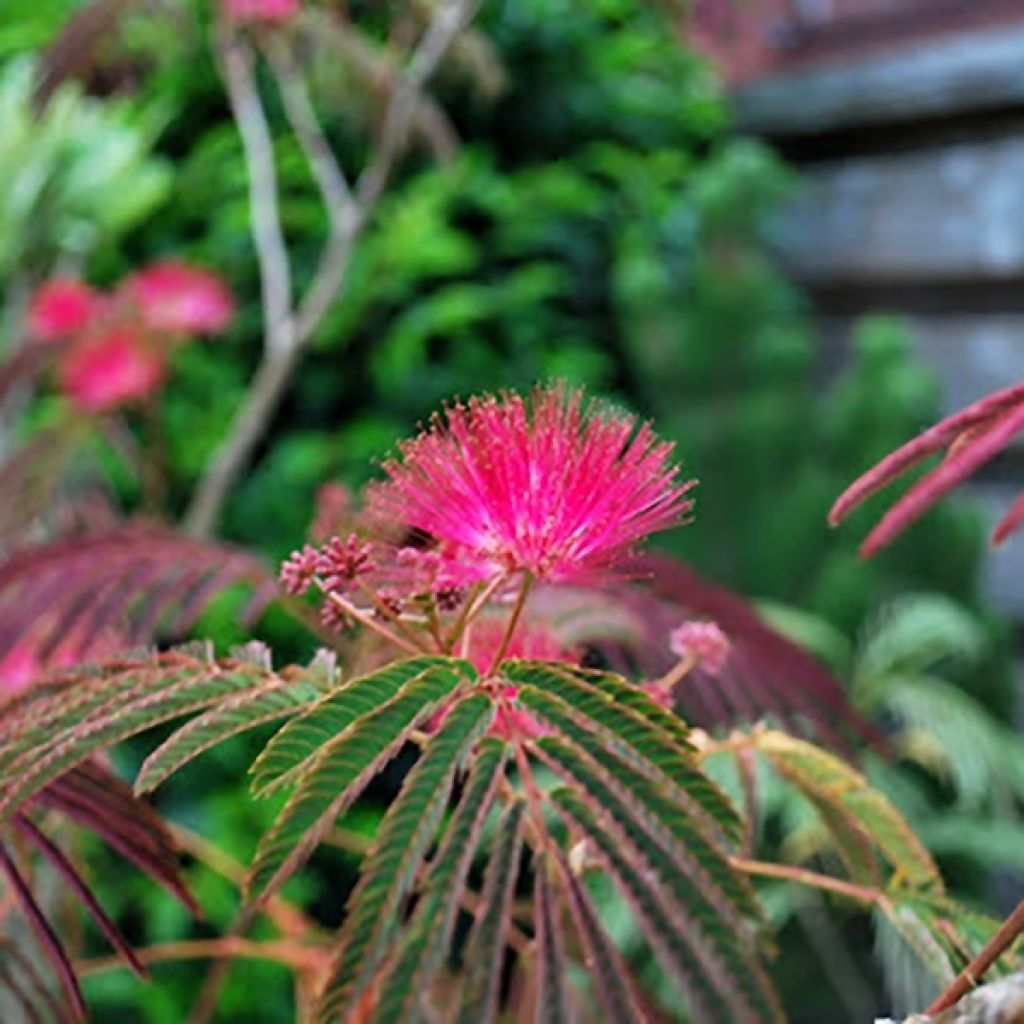

Albizia julibrissin Evi's Purple - Arbre à soie
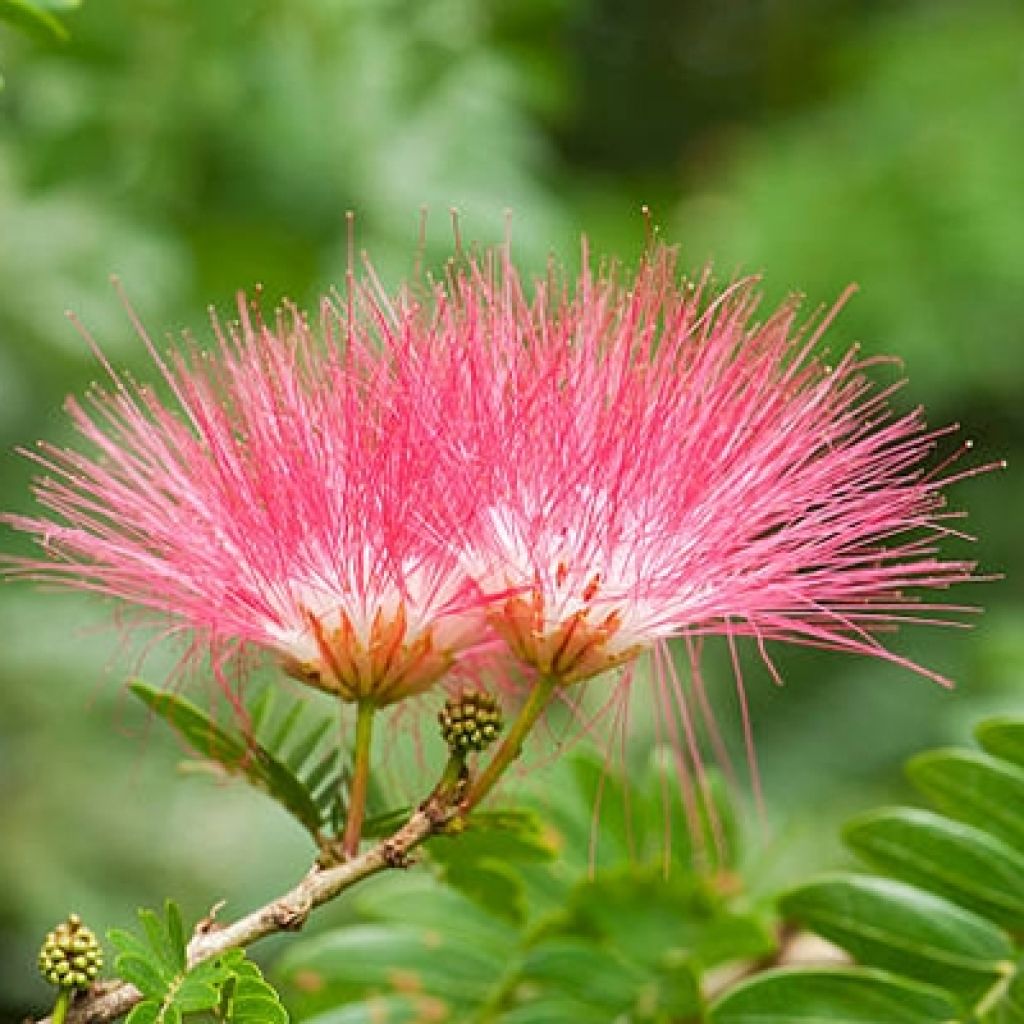

Albizia julibrissin Evis Purple
Albizia julibrissin Evis Purple
Albizia julibrissin Evi's Purple
Persian Silk Tree, Pink Silk Tree, Mimosa Tree, Silk Tree, Persian Acacia
Why not try an alternative variety in stock?
View all →This plant carries a 24 months recovery warranty
More information
We guarantee the quality of our plants for a full growing cycle, and will replace at our expense any plant that fails to recover under normal climatic and planting conditions.
From €5.90 for pickup delivery and €6.90 for home delivery
Express home delivery from €8.90.
Delivery to Corse prohibited: UE law prohibits the import of this plant from mainland France to Corse as part of the fight against Xylella fastidiosa. Please accept our sincere apologies.
More information
Does this plant fit my garden?
Set up your Plantfit profile →
Description
Albizia julibrissin 'Evis's Purple' is a recently developed American variety. More resistant to cold (down to -12 °C) and more vigorous, it is also remarkable for its deep pink flowering, which occurs from July to August depending on the region. Its purple mimosa-like foliage spreads out like an umbrella to offer appreciated shade near a terrace. With its beautiful colours, it brings an undeniable exotic touch to your garden. Albizia julibrissin 'Evis's Purple' is drought-resistant.
Albizia julibrissin is a deciduous small tree of the Fabaceae family, whose original range extends from Iran (formerly called Persia) to eastern China. It is also called Acacia or Constantinople Mimosa.
The cultivar 'Evi's purple' was selected in the United States for its beautiful purple foliage that turns yellow in autumn, its abundant flowering, and its better cold resistance. Its growth is quite slow, favoured by moist soil. It usually reaches a height of 4 to 6 m (13 to 20 ft) in European climates and has a crown-shaped canopy with a diameter equivalent to or slightly larger than its height. It blooms from June to August, during which new flowers open every day. The tree produces feathery and silky inflorescences, which have earned it the name "silk tree". They are actually made up of long stamens of a very deep pink colour, well visible, surpassing the rudimentary corollas grouped in heads. The scent of the flowers is mainly perceptible up close, and is powdery and sweet. The flowering gives way to a fruit, a flat pod 8 to 20 cm (3 to 8 in) long, initially green then brown, containing 5 to 15 fairly large oval seeds, which germinate easily. The leaves, deciduous, fall in autumn after turning yellow. Arranged alternately on the branches, they measure from 15 to 40 cm (6 to 16 in) and are divided into large leaflets, themselves subdivided into small leaflets. In the evening, the leaflets fold in on themselves. The bark is thin, grey-green then grey, almost smooth, with whitish lenticels. Finally, and this is a characteristic of plants of the Fabaceae family, the roots form nodules capable of fixing atmospheric nitrogen through specific bacteria present in these organs. The taproot system of this small tree does not tolerate transplantations well. The lifespan of the Albizia is variable in European climates, usually reaching around thirty years.
Plant the remarkably colourful 'Evi's purple' Silk Tree, with its majestic and airy silhouette, as a standalone tree to provide light shade to the terrace, for example. It likes well-drained soils and needs a sunny site sheltered from the wind. Its blooms add to its exotic aspect. It becomes water-efficient once well rooted, adapts to a wide range of soils (pH from 4.1 to 7.9), requires very little maintenance, and withstands pruning well.
Report an error about the product description
Plant habit
Flowering
Foliage
Botanical data
Albizia
julibrissin
Evi's Purple
Fabaceae
Persian Silk Tree, Pink Silk Tree, Mimosa Tree, Silk Tree, Persian Acacia
Cultivar or hybrid
Other Albizia
Planting and care
Albizia julibrissin Evi's purple is preferably planted in early autumn in southern regions or late winter in regions subject to cold winters. Resistant to -12°C (10.4 °F) without protection once well established, young plants may be more sensitive: choose a warm location, in full sun and sheltered from cold winds. Clayey and heavy soils, saturated with water in winter, will strongly affect its hardiness. In late winter, between February and March and before the start of vegetation, prune out dead, diseased or obstructive wood to maintain a beautiful habit. Severe pruning stimulates numerous vigorous shoots. It is naturally resistant to diseases, tolerates water shortage in summer once established, and sea spray. This tree tolerates a wide range of soils, including poor and slightly calcareous or acidic ones, but will grow faster in cool and fertile soils.
Pests:
Beware of invasions of the Albizia psyllid (Acizzia jamatonica), a tiny flying and piercing insect of greenish color that forms large colonies and produces honeydew promoting the appearance of sooty mould. Its natural predators are the Asian ladybird as well as the larvae of hoverflies and some bugs. The frosted leafhopper can also be a problem in Southern Europe. Do not use any synthetic insecticides! Instead make up a spray bottle of water with soap and alcohol gel and apply lightly, followed by rinsing with a jet of water the next day. This treatment is also effective against psyllids.
Planting period
Intended location
Care
This item has not been reviewed yet - be the first to leave a review about it.
Striking foliage shrubs
Haven't found what you were looking for?
Hardiness is the lowest winter temperature a plant can endure without suffering serious damage or even dying. However, hardiness is affected by location (a sheltered area, such as a patio), protection (winter cover) and soil type (hardiness is improved by well-drained soil).

Photo Sharing Terms & Conditions
In order to encourage gardeners to interact and share their experiences, Promesse de fleurs offers various media enabling content to be uploaded onto its Site - in particular via the ‘Photo sharing’ module.
The User agrees to refrain from:
- Posting any content that is illegal, prejudicial, insulting, racist, inciteful to hatred, revisionist, contrary to public decency, that infringes on privacy or on the privacy rights of third parties, in particular the publicity rights of persons and goods, intellectual property rights, or the right to privacy.
- Submitting content on behalf of a third party;
- Impersonate the identity of a third party and/or publish any personal information about a third party;
In general, the User undertakes to refrain from any unethical behaviour.
All Content (in particular text, comments, files, images, photos, videos, creative works, etc.), which may be subject to property or intellectual property rights, image or other private rights, shall remain the property of the User, subject to the limited rights granted by the terms of the licence granted by Promesse de fleurs as stated below. Users are at liberty to publish or not to publish such Content on the Site, notably via the ‘Photo Sharing’ facility, and accept that this Content shall be made public and freely accessible, notably on the Internet.
Users further acknowledge, undertake to have ,and guarantee that they hold all necessary rights and permissions to publish such material on the Site, in particular with regard to the legislation in force pertaining to any privacy, property, intellectual property, image, or contractual rights, or rights of any other nature. By publishing such Content on the Site, Users acknowledge accepting full liability as publishers of the Content within the meaning of the law, and grant Promesse de fleurs, free of charge, an inclusive, worldwide licence for the said Content for the entire duration of its publication, including all reproduction, representation, up/downloading, displaying, performing, transmission, and storage rights.
Users also grant permission for their name to be linked to the Content and accept that this link may not always be made available.
By engaging in posting material, Users consent to their Content becoming automatically accessible on the Internet, in particular on other sites and/or blogs and/or web pages of the Promesse de fleurs site, including in particular social pages and the Promesse de fleurs catalogue.
Users may secure the removal of entrusted content free of charge by issuing a simple request via our contact form.
The flowering period indicated on our website applies to countries and regions located in USDA zone 8 (France, the United Kingdom, Ireland, the Netherlands, etc.)
It will vary according to where you live:
- In zones 9 to 10 (Italy, Spain, Greece, etc.), flowering will occur about 2 to 4 weeks earlier.
- In zones 6 to 7 (Germany, Poland, Slovenia, and lower mountainous regions), flowering will be delayed by 2 to 3 weeks.
- In zone 5 (Central Europe, Scandinavia), blooming will be delayed by 3 to 5 weeks.
In temperate climates, pruning of spring-flowering shrubs (forsythia, spireas, etc.) should be done just after flowering.
Pruning of summer-flowering shrubs (Indian Lilac, Perovskia, etc.) can be done in winter or spring.
In cold regions as well as with frost-sensitive plants, avoid pruning too early when severe frosts may still occur.
The planting period indicated on our website applies to countries and regions located in USDA zone 8 (France, United Kingdom, Ireland, Netherlands).
It will vary according to where you live:
- In Mediterranean zones (Marseille, Madrid, Milan, etc.), autumn and winter are the best planting periods.
- In continental zones (Strasbourg, Munich, Vienna, etc.), delay planting by 2 to 3 weeks in spring and bring it forward by 2 to 4 weeks in autumn.
- In mountainous regions (the Alps, Pyrenees, Carpathians, etc.), it is best to plant in late spring (May-June) or late summer (August-September).
The harvesting period indicated on our website applies to countries and regions in USDA zone 8 (France, England, Ireland, the Netherlands).
In colder areas (Scandinavia, Poland, Austria...) fruit and vegetable harvests are likely to be delayed by 3-4 weeks.
In warmer areas (Italy, Spain, Greece, etc.), harvesting will probably take place earlier, depending on weather conditions.
The sowing periods indicated on our website apply to countries and regions within USDA Zone 8 (France, UK, Ireland, Netherlands).
In colder areas (Scandinavia, Poland, Austria...), delay any outdoor sowing by 3-4 weeks, or sow under glass.
In warmer climes (Italy, Spain, Greece, etc.), bring outdoor sowing forward by a few weeks.

































